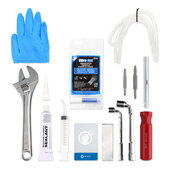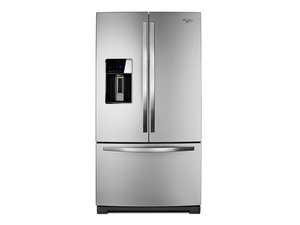Troubleshooting Essentials

$35.95
5
1 reviews
Introduction
If your Frigidaire refrigerator is not making ice anymore, but the water dispenser still works (or only works slowly), don’t lose your cool! This is a common problem. Read on for the most common underlying causes and solutions to get your ice maker working again.
If you need a replacement ice maker, iFixit offers several common ice maker assemblies.
Causes
Whenever your ice maker stops working, check the temperature of the freezer. If the freezer temperature is above 10 degrees F (-12 C) the ice maker will not work properly. It functions best when the freezer temperature is set between 0 and 5 degrees F (-18 to -15 C). If the freezer temp is too high, make sure the condenser coil is clean and the condenser fan is working to cool the condenser and compressor. Check the evaporator coil for frost—if too much frost builds up, the air can't circulate through the coil and you will need to check the defrost components for a failure.
Another reason why the temperature may be unstable is due to a faulty door seal. Without a good seal, temperatures become unstable with warm air seeping into the fresh food door. When the temperature sensor detects the warmer air, the controller keeps the compressor running overtime to maintain the correct 37-degree temperature for fresh food. This excessive cooling causes the freezer temperature to fall well below zero, which will freeze the tip of the water tube that provides the ice maker with water.
Keep in mind that for proper door suction and sealing, the doors need to be self-closing so their own weight helps maintain the seal. The leveling rollers or legs need to be adjusted to tilt the fridge back slightly. When a proper seal is made, within 24 hours the defrost cycles will thaw the water tube and ice production will start.
If the refrigerator ice maker is not working, the door switch might be defective. When the freezer door is opened, the freezer door switch does two things: it turns on the light in the freezer, and turns off the ice maker and dispenser. If the door switch fails, the dispenser will not turn on. The switch can be checked for continuity with an Ohm meter. If it doesn’t have continuity, it should be replaced.
If the temperature is correct but the ice maker won’t work, the water inlet valve might be defective. The water inlet valve is an electrically-controlled mechanical valve that opens to supply water to the dispenser and ice maker. If the water inlet valve is defective, or if it has insufficient pressure, it won’t allow water to flow through. As a result, the ice maker won’t make ice.
The valve requires at least 20 psi to function properly. Make sure that the water pressure to the valve is at least 20 psi. If the water pressure is sufficient, use a multimeter to check for power (continuity) to the water inlet valve. If the water inlet valve has sufficient pressure and is getting power, but the ice maker won’t fill with water to make ice, replace the water inlet valve.
If the ice maker is not working it could be that the ice maker assembly itself is defective. There are several components in the control module of the ice maker that can fail, and most are not sold separately. Also, ice makers have a relatively short lifespan, and may not always be worth fixing. If other, simpler parts like the water inlet valve or shut-off arm have been ruled out, and the only thing left is the ice maker itself, replace it as a unit.

Find compatible replacement parts for your Frigidaire Refrigerator. All parts and fix kits are backed by the iFixit Quality Guarantee.
This thermostat monitors the temperature in the ice maker and determines the appropriate level for ice production, and also cycles on and off the ice maker. If you're experiencing intermittent ice production, or no ice cycling, it's worth testing this component.
- Remove your ice maker, and then remove the control head unit.
- On the backside of the unit, you'll find the thermostat pins.
- To determine if the thermostat is the problem, you'll have to use a multimeter to test continuity. Testing the thermostat at room temperature should read 0Ω.
- Leaving the thermostat in the freezer for several hours and then testing will result in a different reading. Between 16 deg F (-9 deg C) and -4 deg F (-20 deg C), the thermostat will read a value of OL or open loop.
- If your thermostat doesn't behave in this way, it will need to be replaced.

- 5 minutesEasy
If the ice maker is not working the ice level control board might be defective. The refrigerator is equipped with an infrared light beam to detect the level of ice in the ice bucket. As the level of ice reaches the top, the beam is interrupted and the ice maker shuts off. As ice is used up and the level of ice drops below the beam, the ice maker starts up again. If the ice level control board fails, the ice maker will stop making ice.
If the ice maker is not working, the ice maker mold thermostat might be defective. Inside the control module of the ice maker is a thermostat that monitors the temperature of the ice mold (ice tray). Once the mold reaches the proper temperature, the ice maker starts a harvest cycle by ejecting the ice cubes and refilling with water. If the mold thermostat is defective, the ice maker doesn't advance. The thermostat can be checked for continuity. Replace it as needed. The freezer temp should be between 0-5 degrees for optimum performance.
You're seeing solutions for Frigidaire Refrigerator. Select your model to find parts for your device.







